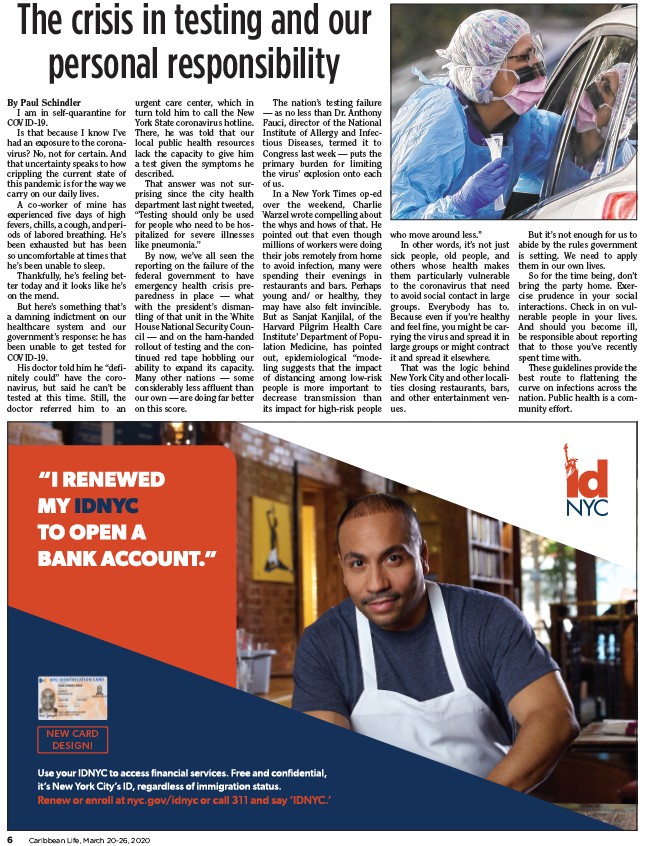
By Paul Schindler
I am in self-quarantine for
COVID-19.
Is that because I know I’ve
had an exposure to the coronavirus?
No, not for certain. And
that uncertainty speaks to how
crippling the current state of
this pandemic is for the way we
carry on our daily lives.
A co-worker of mine has
experienced five days of high
fevers, chills, a cough, and periods
of labored breathing. He’s
been exhausted but has been
so uncomfortable at times that
he’s been unable to sleep.
Thankfully, he’s feeling better
today and it looks like he’s
on the mend.
But here’s something that’s
a damning indictment on our
healthcare system and our
government’s response: he has
been unable to get tested for
COVID-19.
His doctor told him he “definitely
could” have the coronavirus,
but said he can’t be
tested at this time. Still, the
doctor referred him to an
urgent care center, which in
turn told him to call the New
York State coronavirus hotline.
There, he was told that our
local public health resources
lack the capacity to give him
a test given the symptoms he
described.
That answer was not surprising
Caribbean L 6 ife, March 20-26, 2020
since the city health
department last night tweeted,
“Testing should only be used
for people who need to be hospitalized
for severe illnesses
like pneumonia.”
By now, we’ve all seen the
reporting on the failure of the
federal government to have
emergency health crisis preparedness
in place — what
with the president’s dismantling
of that unit in the White
House National Security Council
— and on the ham-handed
rollout of testing and the continued
red tape hobbling our
ability to expand its capacity.
Many other nations — some
considerably less affluent than
our own — are doing far better
on this score.
The nation’s testing failure
— as no less than Dr. Anthony
Fauci, director of the National
Institute of Allergy and Infectious
Diseases, termed it to
Congress last week — puts the
primary burden for limiting
the virus’ explosion onto each
of us.
In a New York Times op-ed
over the weekend, Charlie
Warzel wrote compelling about
the whys and hows of that. He
pointed out that even though
millions of workers were doing
their jobs remotely from home
to avoid infection, many were
spending their evenings in
restaurants and bars. Perhaps
young and/ or healthy, they
may have also felt invincible.
But as Sanjat Kanjilal, of the
Harvard Pilgrim Health Care
Institute’ Department of Population
Medicine, has pointed
out, epidemiological “modeling
suggests that the impact
of distancing among low-risk
people is more important to
decrease transmission than
its impact for high-risk people
who move around less.”
In other words, it’s not just
sick people, old people, and
others whose health makes
them particularly vulnerable
to the coronavirus that need
to avoid social contact in large
groups. Everybody has to.
Because even if you’re healthy
and feel fine, you might be carrying
the virus and spread it in
large groups or might contract
it and spread it elsewhere.
That was the logic behind
New York City and other localities
closing restaurants, bars,
and other entertainment venues.
But it’s not enough for us to
abide by the rules government
is setting. We need to apply
them in our own lives.
So for the time being, don’t
bring the party home. Exercise
prudence in your social
interactions. Check in on vulnerable
people in your lives.
And should you become ill,
be responsible about reporting
that to those you’ve recently
spent time with.
These guidelines provide the
best route to flattening the
curve on infections across the
nation. Public health is a community
effort.
The crisis in testing and our
personal responsibility
NEW CARD
DESIGN!